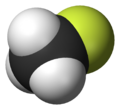| Structural formula |  |  |  |  |
| Name | Fluoromethane Methyl fluoride | Chloromethane Methyl chloride | Bromomethane Methyl bromide | Iodomethane Methyl iodide |
| Melting point | −137,8 °C [1] | −97,4 °C [2] | −93,7 °C [3] | −66 °C [4] |
| Boiling point | −78,4 °C [1] | −23,8 °C [2] | 4,0 °C [3] | 42 °C [4] |
| Space-filling model |  |  |  |  |
The monohalomethanes are organic compounds in which a hydrogen atom in methane is replaced by a halogen. They belong to the haloalkanes or to the subgroup of halomethanes.
Contents
The four common [a] members are fluoromethane, chloromethane, bromomethane and iodomethane.
Historical name for this group is methyl halides; it's still widely used. The compounds of this class are often described as CH3X or MeX (X - any halogen, Me - methyl group).